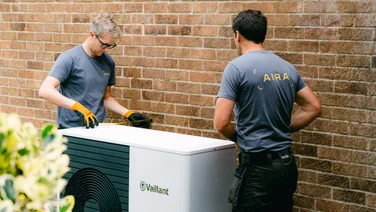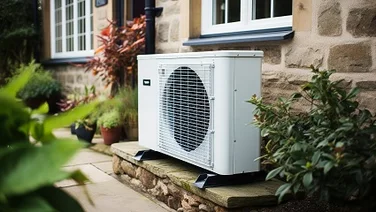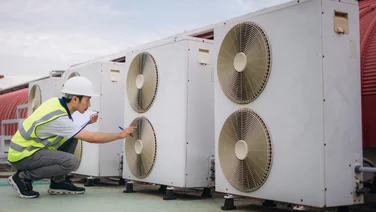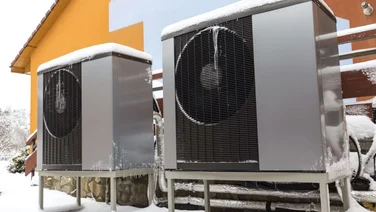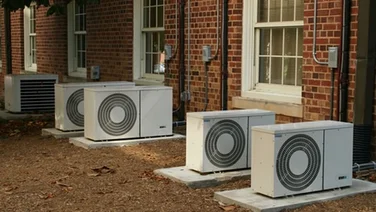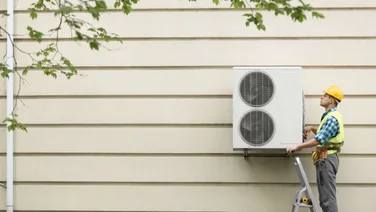- Individual flats generally require smaller heat pumps
- There are five government grants available for heat pumps
- Heat pumps are suitable for flats, provided you have outdoor space (like a balcony) and get permission from the freeholder
- It is important to choose the right type and size of heat pump
Heat pumps are becoming a more common feature in both homes and flats. They Heat pumps are becoming more popular in both homes and flats thanks in part to heat pump grants such as the Boiler Upgrade Scheme. They can gather heat from the air, ground or water, turning it into a clean way to warm your home.
Most people think of heat pumps as for houses, but installing heat pumps in flats is also possible.
In this article, we’ll cover how that works and answer the following questions:
- How much do heat pumps cost if you live in a flat?
- Will a heat pump save you money on your energy bills?
- What government grants for heat pumps are available?
But before we get into the details, according to our latest (2024) National Home Energy Survey, homeowners (59%) are more aware of low-carbon technology (such as heat pumps) compared to non-homeowners (37%).
This suggests that the latter group might be losing out on potentially large savings on energy bills if they took action. If you live in a rented flat and aren’t aware of the huge benefits that heat pumps offer, you could be missing out.
If you’re already clued up on heat pumps and are ready to take the next step to get in touch with an installer, fill in our short form with a few details and we’ll pass them on to certified heat pump installers. They’ll then reach out to you with bespoke, obligation-free quotes for you to compare.

Can you install a heat pump in a flat?
Yes, installing heat pumps in flats is possible, but it can be complex.
First, you can choose either an air-source heat pump or a ground-source heat pump.
Air source heat pumps extract heat from the air to heat your flat, and sometimes hot water. They can extract heat from temperatures as low as -15°C (some units can even handle -25°C). Meanwhile, ground source heat pumps extract heat from the ground and heat radiators, underfloor heating systems and, once again, hot water.
Ground source heat pumps are typically used for blocks of flats, whereas air-source heat pumps are predominantly used for single flats – in a house conversion, for example.
‘What size heat pump do I need?‘ is one of the most common questions people ask when they begin their clean energy journey. Find out which one you need by reading our dedicated guide.
Air source heat pumps for flats
Individual flats usually require smaller air-source heat pumps than you would install for a house. This is because flats tend to have less indoor space to heat.
An air-source heat pump is incredibly efficient for warming a flat or apartment.
If you have access to at least 1sqm of outdoor space, you can install an air source heat pump for your flat.
This is as long as you don’t mind having an outdoor heat pump unit in that outdoor space. If you only have a small balcony, for example, you might not want a heat pump unit to take up space on it.
If you don’t have a balcony, you can install an air source heat pump on the outside wall of your flat, but easy access is required. If you have a flat with a garden, then an air source heat pump is your best option.
It’s important to note that air source heat pumps are considered a permitted development, so you won’t need to apply for installation permission. However, if you’re a leaseholder, you’ll need to check your lease to see if you need permission first from the freeholder of your property.
If an outdoor heat pump is unlikely to work with your flat, there are also options for using a portable heat pump. These are plug-in models that can heat or cool a single room.
Ground source heat pumps for flats
The building must have sufficient outdoor space to install a shared ground-source heat pump in a block of flats. The area needed depends entirely on the system considered and the heating capacity needed.
As a rough guide, the surface area of land required is roughly 2.5 times the square meterage of the property.
When these so-called shared ground loop systems are installed, the portion of the ground source heat pump that draws heat from the earth is trenched in the ground near the block of flats and connected to individual indoor units installed inside each flat.
If you want to know how much a heat pump will set you back, take a look at our heat pump cost calculator.
Like other heat pump systems, a ground source heat pump is considered a permitted development for property owners.
Also, each flat has access to its own indoor unit (connected to the ground source heat pump) and is billed according to its electricity use. That means a flat won’t pay more if another flat in the block has a higher electricity usage.
Is it cost effective to install a heat pump in a flat?
One of the disadvantages of installing a heat pump system in a flat is the payback period.
On average, a heat pump system pays for itself in seven years, but it can vary depending on the property’s size and the system’s use.
An air-source heat pump costs around £10,000, while a ground-source heat pump costs £24,000, on average. The savings amount for a three-bedroom house after 20 years is £4,082.
However, the system will always pay for itself in the long run due to its efficiency. And, heat pumps help the environment by reducing emissions of polluting gases.
Will I need to make big changes to my flat?
It’s unlikely you’ll need to do much to your flat, aside from insulation but you might need to make some insulation improvements.
Heat pumps are designed to operate most efficiently at a lower but consistent temperature. This contrasts with traditional gas boilers, which deliver a rapid blast of high heat when fired up.
For this reason, it is essential to ensure that heat loss in your building, including in communal areas, is as low as possible so you can maximise efficiency and benefit from your heat pump.
The good news is that, compared to houses, flats are likely to have better insulation because they have fewer external walls.
You won’t need to upgrade your flat if you already have a balcony or garden, because you’ll be able to install an air source heat pump outside. However, an upgrade might be needed if a ground source heat pump is installed for the whole building.
You also won’t need to make drastic changes to reduce the noise from a heat pump, as they’re generally very quiet – no louder than 40-60 decibels.
If you’re a landlord, you won’t be forced to install heat pumps, but gas boilers will eventually be phased out. The argument then, is that you might want to consider getting ahead of the curve and installing a heat pump in any flats you currently rent out.
How much does a heat pump for a flat cost?
The price of an air source heat pump can vary between £4,500 and £10,000, according to EDF Energy, which will be dependent on several factors, such as:
- How powerful the unit is
- The brand of the heat pump
- Government grants
- Installation costs
If you live in England and Wales, heat pump costs include installation and a government grant of £7,500, available through the Boiler Upgrade Scheme.
Scotland also has installation and a government grant of £7,500, which is run through the Home Energy Scotland grant.
If you live in Scotland, you can apply for an interest-free loan of up to £7,500 to cover the remaining installation costs.
Ground source heat pump costs for shared usage vary between £4,500 and £49,000. The lower cost will be for a compact heat pump, while the more expensive heat pumps will be for your garden or shared buildings. These costs also include installation costs.
These costs will also be dependent on several factors, including:
- The size of the block of flats
- How many flats are in a block
- The complexity of the installation (vertical installations cost more than horizontal installations, for example)
To learn more about heat pump costs, check out our full guide.
What type of central heating do you currently use?
Get started
An air source heat pump installed on an exterior wall
What are the first steps for installing a shared heat pump?
You’ll need the freeholder’s permission to install a shared heat pump for a block of flats. If you’re renting, this will most likely be your landlord, the building’s managing company or the corporation that owns the land.
Shared heat pump technology is still relatively new too, so only a few installers are qualified for this type of installation.
For example, Vaillant – one of Europe’s largest heating technology developers – only showcased its first heat pumps designed specifically for flats in March 2023.
Kensa, who exclusively manufactures ground source heat pumps, has successfully installed shared ground source heat pumps in flats.
In February 2024, the Cornwall-based installer announced it was launching a new concept ground source heat pump, the ‘Shoebox NX’.
The electric heat pump is designed to be connected to a network of pipes, similar to a gas network, that draws ambient heat from holes drilled deep into the ground, using it to power the pumps to produce heat.
If you’re considering replacing a communal boiler with a heat pump, it’s important to make sure you have the support of all the residents, as they’ll be sharing the costs. This process will probably require an installer to give quotes and an estimate of the impact of a heat pump on energy bills.
What government grants are there for heat pumps in flats?
Currently, five government grants are available for home heat pump installations in the UK:
These grants weren’t created specifically for flats, but there’s no stipulation that people who live in flats can’t use them, as long as they meet the eligibility criteria.
You can see a summary of the available schemes in the table below, but if you need more detail, head to our page on heat pump grants.
Grant | What it offers | Who it’s for |
|---|---|---|
Boiler Upgrade Scheme | £7,500 towards the cost of buying and installing an air source heat pump | Homeowners, small landlords, and private landlords in England and Wales |
ECO4 | Covers some of the cost, but the amount depends on the energy supplier and the individual’s circumstances | Low-income households (homeowners and renters) who meet certain benefits criteria |
Warmer Homes Scotland | Covers up to 100% of the costs | Homeowners or renters living in Scotland who meet certain benefits criteria |
Private Rented Sector Landlord Loan | Up to £15,000 towards energy efficiency improvements | Landlords in Scotland who are listed on the Scottish Landlord Register |
Nest Wales | Covers up to 100% of the costs | Homeowners or renters living in Wales, who live in an energy inefficient home, and who meet certain benefits criteria |
Private Rented Sector Landlord Loan (Scotland)
While there are no specific grants for flats, the Private Rented Sector Landlord Loan is designed to help registered private landlords in Scotland improve the energy efficiency of their properties.
Funding is available for businesses owned:
- By an individual in their capacity as a sole trader
- By some or all of the members of an incorporated association in trust for the association
- By either:
- A limited company,
- a limited liability partnership, a trust, a partnership, a registered society under the Co-operative and Community Benefit Societies Act 2014,
- Scottish Charitable Incorporated Organisation
- In any other capacity which Energy Saving Trust or the Scottish Government considers to be a business
Landlords can apply for up to two renewable systems per property, worth up to £17,500, plus an energy storing system up to a maximum of £6,000. This loan applies to multiple different types of renewable energy sources. For heat pumps, this loan is a maximum of £10,000.
Case study: High rise apartments in Thurrock
Three tower blocks containing 273 flats were retrofitted with shared ground source heat pumps between 2022 and 2023. The outdated storage heaters in the flats were replaced with individual heat pump units connected to a shared ground loop.
The project was a collaboration between Thurrock Council in Essex, which owns the tower blocks, and ground source heat pump installers, Kensa.
It was partly funded by the government’s Social Housing Decarbonisation Fund, which awarded Thurrock Council £3.2m for the installation.
Residents of the flats have reported that the new system is better at keeping their homes warm.
According to Kensa Contracting, replacing the energy-inefficient storage heaters with a ground source heat pump helped residents in one of the two-bedroom flats save around £952 a year on their energy bills.
Next steps
It might be trickier to install heat pumps for flats than houses, but that’s not because flats are poorly suited to them. As we’ve discussed, you can install a heat pump on any property; it’s all about what is right for you.
Moreover, a 2020 government-funded project called the Electrification of Heat found that all properties are suitable for a heat pump. The project was designed to test heat pumps in different types of homes, and heat pumps were successfully installed in everything from flats to Victorian houses.
Remember, an air source heat pump is probably your best option if you live in a small flat with a balcony or garden. If you live in a flat with little or no access to outdoor space, consider looking at an electric alternative to a heat pump.
However, if you’re a landlord who owns an entire block of flats with some land attached to it, then you could have the option to install a larger air-source or ground source heat pump.
If you want to find out more about what heat pump is best for your property, we can help.
Simply fill in our form, and we’ll pass it on to the professional heat pump installers. They’ll reach out to you directly with obligation-free quotes and expert advice.
Summary
- The average two-bedroom flat needs a 4-5kW air-source heat pump or a 4kW ground-source heat pump.
- The heat pump size that a flat needs varies, depending on how big and well-insulated the flat is. Smaller flats need smaller heat pumps – larger/poorly insulated flats need larger heat pumps.
- Landlords will not be forced to install heat pumps, but gas boilers will eventually be phased out (even if not by the originally proposed date of 2035), so it makes sense to consider your options now.
- Heat pumps produce some noise while operating, but this maximum is 40-60 decibels. For context, this is roughly the same noise level as a fridge.


